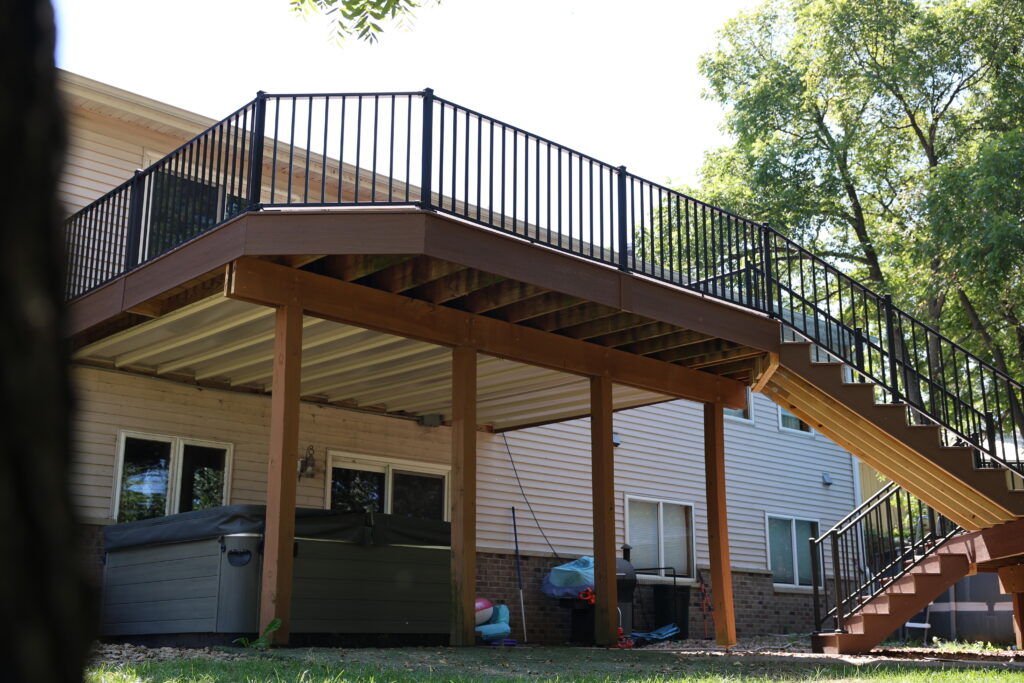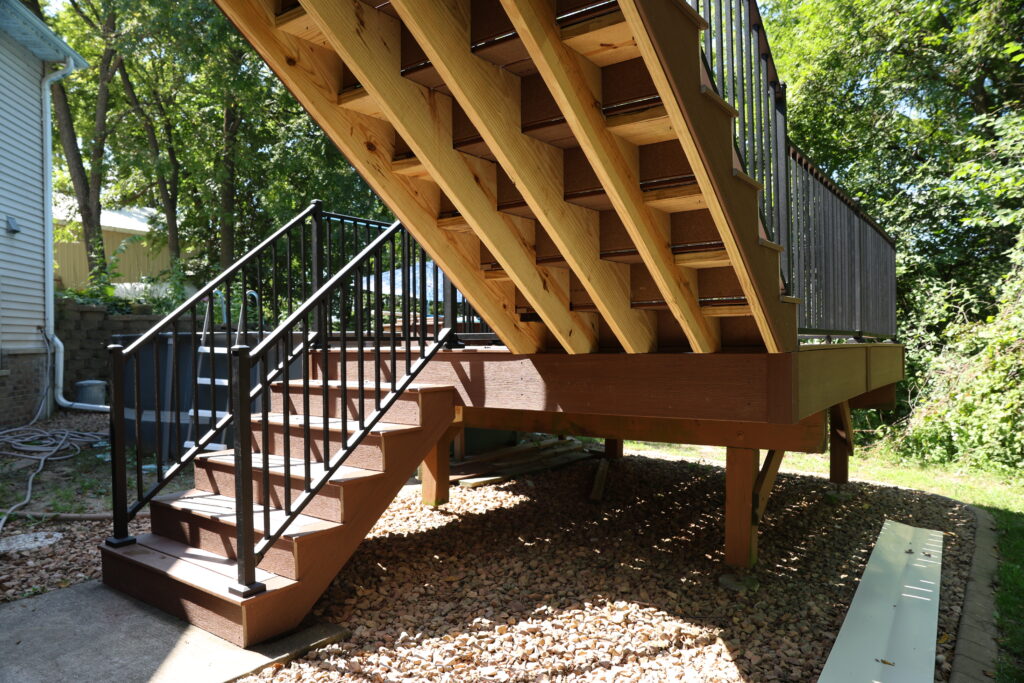Decks are the unheralded heroes of outdoor living: They support summertime BBQs, family get-togethers, and a lot of morning yoga. But the sturdiest decks also wear down over the years. As a homeowner, how do you know when some patch jobs will just cover up the issue… and what are the signs that it’s time to replace everything?
This in-depth guide walks you through the most important indicators, structural red flags, estimated lifespans, cost comparisons, and inspection tactics so you can make the best choice for your home, safety, and wallet.
How Long Does a Deck Typically Last?
The lifespan of your deck depends largely on the materials used, how well it’s maintained, and your local climate.
General Lifespan Benchmarks:
- Pressure-Treated Wood Deck: 15–20 years
- Cedar or Redwood Deck: 20–25 years
- Composite Deck (e.g. Trex, TimberTech): 25–30+ years
- PVC or Aluminum Decking: 30–50 years
However, these are just averages. That can dramatically shorten the life of a deck if it does not benefit from any of those three contributors to its longevity: harsh winters, bad drainage, or skipped maintenance.
Signs Your Deck Might Just Need Repairs
Minor wear and tear is, of course, to be expected — and often fixable.
Common Repairable Issues:
- Loose or popped nails/screws: Hammer in and re-nail/re-screw or replace with rust-resistant deck screws.
- Splintered boards: Either sand or replace individual boards.
- Staining or discoloration: Clean, strip, and restain or paint.
- Loose railings: Tighten bolts or shore up the connections at these points.
- Surface mildew or algae: Clean the surface with deck cleaner. Apply sealer.
If the frame on your deck is solid and it doesn’t face extreme exposure to weather, your maintenance efforts should give you a few more years of serviceable use.

Warning Signs It’s Time for Deck Replacement
Some issues can’t be solved by cosmetic fixes. If you find any of these, a full replacement should probably be the safer and more budget-considerate solution.
Major Red Flags:
- Spongy, soft, or rotten boards — often indicative of moisture damage deep within the interior.
- Split, cracked support; split or cracked beams (impairment of structural capacity).
- Extensive insect damage — particularly termites or carpenter ants.
- Sag or bounce in the floor when you walk — might be weakened joists.
- Rusty or corroded fasteners — upsets the system.
- Ledger board problems — If the board that connects your deck to the house is failing, then your entire deck’s attachment to the house could be at risk.
Decks more than 20 years old with multiple problems aren’t worth patching. A new build brings safety, current code compliance, and the ability to upgrade materials.
Should You Replace or Resurface Your Deck?
Many homeowners inquire: “Can I just replace the boards and leave the frame?” That depends.
Resurfacing Makes Sense If:
- The substructure (joists, beams, and posts) is in great condition.
- Yours is a young deck (less than 15 years old).
- There’s no rot, warping, or insect damage in concealed places.
- You need to replace a surface material (like from wood to composite).
And if your frame is warped or old, resurfacing could be a stopgap solution to a long-term problem. Before replacing the surfaces, be sure to inspect it thoroughly.
What’s the Cost Difference? Repair vs. Replace
Average Deck Repair Costs:
- Minor Repairs: $250 – $1,000
- Major Structural Repairs: $1,500 – $4,000
Average Deck Replacement Costs:
- Wood Deck (Basic): $5,000 – $12,000
- Composite Deck: $12,000 – $20,000+
Cost is affected by labor and materials. Composite decks are more expensive initially but also last longer and never need to be stained or painted. You need a complete bid from a contractor to make that kind of comparison.
Don’t Forget About Building Codes
Older decks may not be up to code railing height, stair spacing, and fastener types. If your deck was built 15 to 20 years ago, or was constructed by a previous owner, it may not be up to code.
Code Violations Often Include:
- Railings under 36″ in height
- Stair risers that vary in height
- Baluster spacing wider than 4″
- Improper or missing ledger attachments
A professional inspection can pick up these risks and prevent potential safety or insurance issues.

Can You DIY or Should You Hire a Contractor?
DIY Deck Repairs:
- If you already have the tools and know-how, it’s budget-friendly
- Ideal for bolt tightening, board replacement, light sanding, and staining
When to Hire a Pro:
- Any structural work
- Joist, beam, or footing replacement
- Full deck tear-down or rebuild
- Conversion to composite or advanced materials
Don’t take any chances if safety or permits are at stake. Get a licensed general contractor who specializes in your area’s building code and engineering.
What Materials Should You Choose If Replacing?
There are more choices than ever in modern decks:
Natural Wood:
- Pressure-treated pine – Cheap and widely available
- Cedar or redwood – Beautiful, and naturally rot-resistant
Composite:
- Recycled plastic and wood fiber construction
- Extremely durable and low-maintenance
- Brands: Trex, TimberTech, Fiberon
PVC:
- All-plastic boards (no wood content)
- Ultra low-maintenance, fade- and mold-resistant
- More expensive but longer lifespan
Your decision will likely come down to a matter of budget, climate, and aesthetics. In wet, moist regions, composite or PVC might be more cost-effective options over the long term.
Final Thoughts: When in Doubt, Get a Professional Opinion
Issues with the deck aren’t always black and white. A crack in the surface may appear to be a minor issue, but it can be the tip of an iceberg of rot. Although a loose railing can be trivial to repair — or not so trivial if you have Columbus Tower-style wrought iron doing its best Oberon E. Rhys impression — and may indicate nothing worse than shifting footings or frame instability, it could also indicate closer contact with the sidewalk.
That’s why an expert opinion is crucial, especially if:
- You’re planning to sell your home
- You have guests over often and safety is a concern
- You are thinking about changing materials (like moving from wood to composite)
- You don’t know if repairs will make it worth the cost
Experienced contractors are not simply looking at the visible damage. They inspect structural framing, monitor fasteners and check spacing and drainage — some can even test the moisture content in your wood. They’ll also play a role in figuring out if your existing deck is up to code in your area — which could have changed since it was initially constructed.
If your deck has concealed dangers or outdated materials, finding them now may help prevent a bigger issue later on — such as injuries, violations, or re-dos that could have been avoided.
What You Should Ask Your Deck Inspector:
- What’s the current condition of the substructure?
- How long will these repairs realistically hold up?
- Is my deck code-compliant?
- Can I safely switch to low-maintenance decking?
- What warranties are available for repair vs. replacement?
A good contractor should provide a clear, itemized estimate that spells out the options so you make the call on what’s best for your budget and long-term plans.
